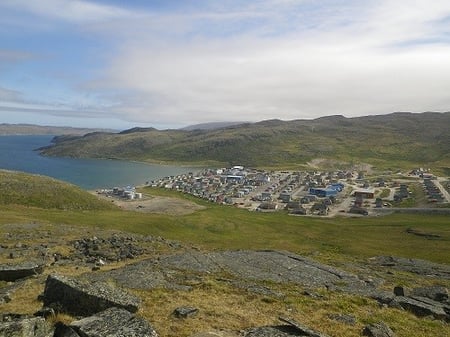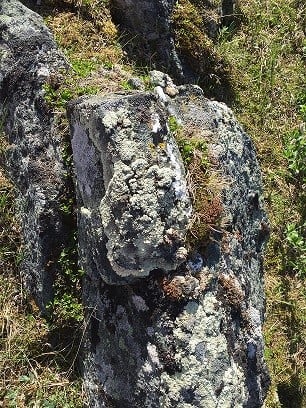A chilly morning with moderate wind. Geared up and all prepared for another sampling day, and this time I’d decided to climb the north-west slope of the Salluit Valley, which is sandwiched by about 300-m slopes.
The north-west hill was covered with tussock grasses and swampy areas. Tracks of ATV (all-terrain-vehicle) can be seen all the way uphill. The climb was gradual but tough. Once I reached the top, the breath-taking sight of the Sugluk Fjord and the Salluit Valley was spectacular.
I took several minutes to look around the rocks searching for interesting lichen inspirations. There, an inspiration of the “exposed” and the “sheltered” came to me. Some rock tripe lichens colonized the rock surfaces exposed to locally dominant winds, while the others were sheltered. My inspired hypothesis was that the two contrastive micro-habitats may tend to support two distinct growth forms of the rock tripe lichens. Indeed, sparse, individual moderate-size thalli were found on the protected side, and clustered smaller rock tripe thalli on the exposed side.
Rock tripe pattern of distribution provoke the thought; is there difference in bacterial flora associated with exposed, partially exposed and protected rock tripe specimens? The sites experienced possibly different intensities of environmental elements like wind, rain, snow etc. Being interested in these two different environmental parameters, I collected rock tripe specimens from these two sites. Dark clouds formed at the far east side of Salluit, so I decided to head down just in case strong wind and rain made it more difficult to go down. As descended downhill, the clouds seem to move away, clearing the sky. I then decided to check another clustered of rock boulders found at the bottom of the hill.
The clustered of rock boulders were like a “jewel box”, being covered with various type of lichens, and mosses, presenting an interesting sympatry of lichens. Here, lichen species of diverse types share space, nutrients, and underwent same environmental conditions. The fascinated growths of diverse forms of lichens, covering the rock boulders aroused my curiosity to know if associated bacterial flora for each lichen species are similar in composition or not. I then collected rock tripe specimens, and other types of lichen forms that share the same microhabitat, i.e., sympatric, with rock tripe lichens.
Merry Sailonga Faluaburu






